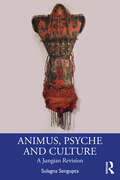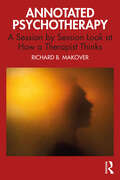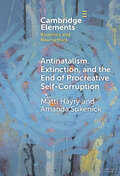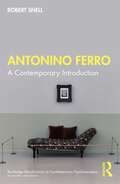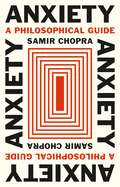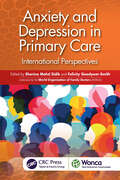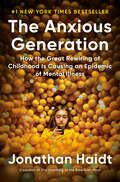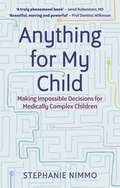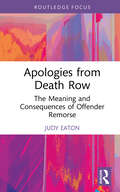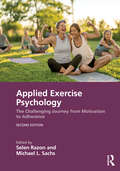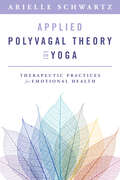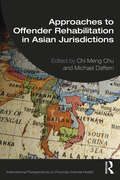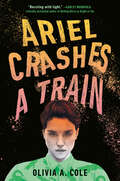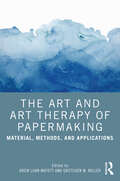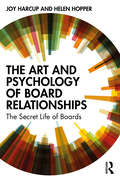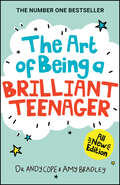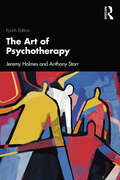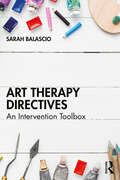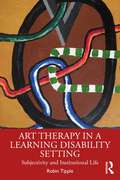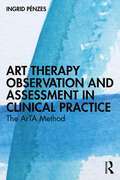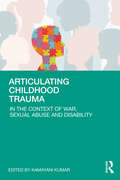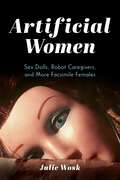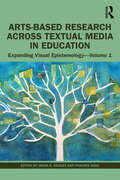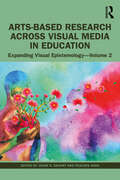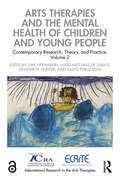- Table View
- List View
Animus, Psyche and Culture: A Jungian Revision
by Sulagna SenguptaAnimus, Psyche and Culture takes Carl Jung’s concept of contra-sexual psyche and locates it within the cultural expanse of India, using ethnographic narratives, history, religion, myth, films, biographical extracts to deliberate on the feminine in psychological, social and archetypal realms. Jung’s concept of unconscious contra-sexuality, based on notions of feminine Eros and masculine Logos, was pioneering in his time, but took masculine and feminine to be fixed and essential attributes of gender in the psyche. This book explores the relevance of the animus, examining its rationale in current contexts of gender fluidity. Taking off from Post Jungian critiques, it proposes an exposition of the animus in history, social and religious phenomena, theories of knowledge, psychoid archetype and synchronicity, to grasp its nuances in diverse cultural worlds. This study re-envisions the notion of animus keeping in mind the intricacies of feminine subjectivity and the diversity of cultural worlds where depth psychological ideas are currently emerging. A remarkable reworking of Jungian ideas, this well-researched and important new book will be an insightful read for Jungian analysts and scholars with an interest in cultural and gender studies.
Annotated Psychotherapy: A Session by Session Look at How a Therapist Thinks
by Richard B. MakoverAnnotated Psychotherapy demonstrates how an experienced psychotherapist develops and carries out the right treatment plan through interactions with the patient or client. In these pages, clinicians will find an explanation of everything the therapist says to patients or clients: why they say it, what they intend it to do, how it fits in with the treatment plan for that person, and, importantly, what might have been said that would be better. Each of the eight sessions are presented in the form of a transcript that shows how a seasoned clinician might conduct the session—what their internal judgments are and what reasoning or rationale they might have for the therapeutic interventions they choose. Discussion sections after each transcript and a glossary provide helpful explanatory material for the key ideas and concepts, making this book an enlightening resource for therapists working and training in psychotherapy, whether their background is psychology, social work, psychiatry, or counseling.
Antinatalism, Extinction, and the End of Procreative Self-Corruption (Elements in Bioethics and Neuroethics)
by null Matti Häyry null Amanda SukenickThis Element provides an exploration of antinatalism, the view that assigns a negative value to reproduction. First, the history of Western philosophy as a two-and-a-half millennia reaction to antinatalist sentiments. Human life has no obvious meaning and philosophers have been forced to build elaborate theories to invent imaginary purposes. Second, analysis of the concept of antinatalism in the light of human extinction. If people stop having children, the species will cease to exist, and this prospect has prompted attempts to find alternatives and excuses. Third, outlines a normative view defending antinatalism both theoretically and practically. If it is wrong to bring about suffering in the absence of redeeming meaning and if it is possible to create meaning only by imposing a pronatalist mentality upon children before they can make up their own minds, parents morally corrupt themselves by procreating. This title is also available as Open Access on Cambridge Core.
Antonino Ferro: A Contemporary Introduction (Routledge Introductions to Contemporary Psychoanalysis)
by Robert SnellThis book provides a clear, thorough, and accessible introduction to the work of Antonino Ferro and draws on the clinical vignettes that punctuate his writings to show how Ferro has built on Bion’s revolutionary achievements to develop a distinctive, game-changing version of field theory in psychoanalysis.The book clarifies the phenomenological insight that the analyst and the patient together generate an ever-evolving, intersubjective field. Rather than the supposed psychology of the individual, it is this populous and multidimensional field, a co-created ‘in-between’ rich in characters and stories, that is to be explored and elaborated. The primary points of access to this new ‘multiverse’ are dream, reverie, metaphor, and imagination. A radical Negative Capability is called for, not least to help dissolve co-constructed ‘bastions’ obstructing the field’s expansion. The book sketches out the Italian and international context in which Ferro developed his thinking and addresses some key critical questions. It concludes that Ferro’s life’s work, which marries theoretical rigour with a revitalising increase in playfulness and freedom of response, is a transformational force within psychoanalysis and a major catalyst in its evolution.This important volume is rewarding reading for beginning and seasoned analysts alike, as well as for psychotherapists, counsellors, humanities scholars, and anyone interested in psychoanalysis.
Anxiety: A Philosophical Guide (Moral Psychology Of The Emotions Ser.)
by Samir ChopraHow philosophy can teach us to be less anxious about being anxious by understanding that it&’s an essential part of being humanToday, anxiety is usually thought of as a pathology, the most diagnosed and medicated of all psychological disorders. But anxiety isn&’t always or only a medical condition. Indeed, many philosophers argue that anxiety is a normal, even essential, part of being human, and that coming to terms with this fact is potentially transformative, allowing us to live more meaningful lives by giving us a richer understanding of ourselves. In Anxiety, Samir Chopra explores valuable insights about anxiety offered by ancient and modern philosophies—Buddhism, existentialism, psychoanalysis, and critical theory. Blending memoir and philosophy, he also tells how serious anxiety has affected his own life—and how philosophy has helped him cope with it.Chopra shows that many philosophers—including the Buddha, Kierkegaard, Nietzsche, Freud, and Heidegger—have viewed anxiety as an inevitable human response to existence: to be is to be anxious. Drawing on Karl Marx and Herbert Marcuse, Chopra examines how poverty and other material conditions can make anxiety worse, but he emphasizes that not even the rich can escape it. Nor can the medicated. Inseparable from the human condition, anxiety is indispensable for grasping it. Philosophy may not be able to cure anxiety but, by leading us to greater self-knowledge and self-acceptance, it may be able to make us less anxious about being anxious.Personal, poignant, and hopeful, Anxiety is a book for anyone who is curious about rethinking anxiety and learning why it might be a source not only of suffering but of insight.
Anxiety and Depression in Primary Care: International Perspectives (WONCA Family Medicine)
by Sherina Mohd Sidik Felicity Goodyear-SmithThis book provides practical information about depression and anxiety in primary care, with a focus on the approach in different countries and incorporating global ranges/prevalence, risk factors and health burden including that associated with COVID-19 and its pandemic. To ensure the challenges of a wide international primary care community are reflected fully, authors from different world regions – Africa, Asia Pacific, East Mediterranean, Europe, IberoAmericana-CIMF, North America and South Asia – have co-contributed to individual chapters on the detection and management of depression and anxiety in primary care in their own countries, including the screening tools used, how widely these tools are adopted and by whom, and current policies. As well as the medical model, it also presents the alternative viewpoint that feeling low or anxious is part of the human condition and the attention should be on supporting people in their journey through life, struggling to deal with the mainly social challenges they meet, rather than defining these problems as disorders or diseases requiring identification and treatment. Key Features: Explores the instruments used for the detection of depression and anxiety in primary care in various countries, and why and how these instruments are being used Describes the pharmaceutical and non-drug interventions for treating depression and anxiety in primary care and compares the similarities and differences in detecting and managing depression and anxiety in primary care among different countries Includes in-depth regional examples of how screening tools are used in practice and how policies can be established in the management of depression and anxiety in primary care Concludes with lessons learned from various countries and from different stakeholders with clear advice on what to do and, importantly, what not to do Addressing primary care detection and management of mental health issues across the globe, the book will be an invaluable practical aid for family medicine practitioners and the wider primary and community care teams and a useful reference for those involved in policy setting at regional and national levels including ministries of health.
The Anxious Generation: How the Great Rewiring of Childhood Is Causing an Epidemic of Mental Illness
by Jonathan HaidtFrom New York Times bestselling coauthor of The Coddling of the American Mind, an essential investigation into the collapse of youth mental health—and a plan for a healthier, freer childhood. <p><p> After more than a decade of stability or improvement, the mental health of adolescents plunged in the early 2010s. Rates of depression, anxiety, self-harm, and suicide rose sharply, more than doubling on many measures. Why? <p><p> In The Anxious Generation, social psychologist Jonathan Haidt lays out the facts about the epidemic of teen mental illness that hit many countries at the same time. He then investigates the nature of childhood, including why children need play and independent exploration to mature into competent, thriving adults. Haidt shows how the “play-based childhood” began to decline in the 1980s, and how it was finally wiped out by the arrival of the “phone-based childhood” in the early 2010s. He presents more than a dozen mechanisms by which this “great rewiring of childhood” has interfered with children’s social and neurological development, covering everything from sleep deprivation to attention fragmentation, addiction, loneliness, social contagion, social comparison, and perfectionism. He explains why social media damages girls more than boys and why boys have been withdrawing from the real world into the virtual world, with disastrous consequences for themselves, their families, and their societies. <p><p> Most important, Haidt issues a clear call to action. He diagnoses the “collective action problems” that trap us, and then proposes four simple rules that might set us free. He describes steps that parents, teachers, schools, tech companies, and governments can take to end the epidemic of mental illness and restore a more humane childhood. <p><p> Haidt has spent his career speaking truth backed by data in the most difficult landscapes—communities polarized by politics and religion, campuses battling culture wars, and now the public health emergency faced by Gen Z. We cannot afford to ignore his findings about protecting our children—and ourselves—from the psychological damage of a phone-based life. <p> <b>New York Times Bestseller</b>
Anything for My Child: Making Impossible Decisions for Medically Complex Children
by Stephanie NimmoEvery parent wants the same thing: for their child to enjoy a long and fulfilling life. But what happens when things don't go according to plan? What happens when parents have to become advocates for their child's healthcare needs? Who decides what is in a child's 'best interests'?Stephanie Nimmo faced these questions first-hand when her daughter, Daisy, was diagnosed with a life-limiting condition as a baby. Seen through the lens of Stephanie's own experiences, this sensitive book delves into the complex world of medical ethics and paediatric palliative care. From recognising tipping points to the importance of building relationships with palliative care teams well before crisis, this book explores how medical professionals can better support families throughout their child's care.Interviews with clinicians and snapshots from the lives of patients' families provide insight into the realities of life on both sides of the hospital bed. Compassionate explanations of the conflicting pressures in the hospital system foster understanding and help medical professionals and families work together.
Apologies from Death Row: The Meaning and Consequences of Offender Remorse (Routledge Studies in Criminal Behaviour)
by Judy EatonApologies from Death Row explores the notion of remorse, apologies, and forgiveness within the context of capital punishment in the United States, through the final words of offenders on death row, and the covictims’ responses to them in their statements to the press after witnessing the execution. The book demonstrates that there is evidence that some offenders on death row are truly remorseful and that some of the family members of their victims could benefit from this remorse, but that this is unlikely in the current system of capital punishment. Drawing from the fields of criminology, psychology, and sociology, the book begins with a theoretically informed introduction to the concepts of remorse and forgiveness, followed by an exploration of apology and forgiveness specifically in the context of capital punishment. It discusses how some initiatives within the criminal justice system, such as apology laws and restorative justice programmes, are being used to make it easier for offenders to apologize to their victims. Offenders on death row are considered, addressing why they might or might not apologize, and whether they are even capable of showing true remorse. The book then considers the family members of their victims ("covictims"), addressing whether they benefit from hearing the offender express remorse and witnessing the execution, and whether forgiveness is possible in this context. Evidence to support the arguments presented in the book come from the offenders’ final words and the covictims’ responses to them in their statements to the press. The book dispels two common myths about the death penalty. First, it shows that offenders on death row are not simply "monsters" who are incapable of understanding the severity of their crimes. Second, it provides evidence that, despite the popular belief that the death penalty is necessary in order to provide closure for the victims’ family members, it may actually have the opposite effect. The family members’ statements to the press after witnessing the execution contain more negative themes like anger and disappointment than positive themes like closure and peace. The book concludes with a discussion of the implications this has for systems of justice in general, and how a better understanding of the emotional state of offenders can help both victims and offenders. Apologies from Death Row will be of great interest to students and scholars of Criminology, Psychology, and Sociology.
Applied Exercise Psychology: The Challenging Journey from Motivation to Adherence
by Selen Razon Michael L. SachsNow in its second edition, Applied Exercise Psychology emphasizes the application of evidence-based knowledge drawn from the fields of exercise psychology, health psychology, clinical and counseling psychology, and exercise physiology for physical activity behavior change. Thoroughly revised, the new edition offers readers: two new chapters covering Excusercise and Mood Alteration’s link to exercise; fully updated sections on current research and theoretical bases for understanding and promoting physical activity behavior; interventions for facilitating physical activity behavior change and the tools for measuring the effectiveness of these interventions; cross-cultural considerations for practitioners to ensure multicultural competency; considerations to guide best practices with special populations (e.g., persons with medical conditions and persons with mental health conditions); overall applied implications and future directions. An essential read that covers a variety of critical topics in applied exercise psychology, it brings often overlooked issues to the attention of practitioners to promote not only evidence-based practice but also responsible ethics and referral. The collection is a key reference for up-to-date research findings, relevant field experiences, and applied implications.
Applied Polyvagal Theory in Yoga: Therapeutic Practices for Emotional Health
by Arielle SchwartzTreat trauma holistically with the combined applications of yoga and polyvagal theory. This book focuses on the intersection of polyvagal theory, yoga, and psychotherapy by weaving together the wisdom tradition of yoga with neuroscience, attachment theory, somatic psychology, and traumatology. The application of polyvagal theory allows practitioners to compassionately support growth by enhancing the health of the autonomic nervous system, while therapeutic yoga allows one to attend to the interrelationships between mind, emotions, physiology, and behavior. Applied Polyvagal Theory in Yoga provides conscious breathing, vagal toning, mindful movement, and meditation practices that aid in rewiring the nervous system. Readers will discover how to help both clients and themselves cultivate a felt sense of ease during times of safety; enhance their capacity to handle challenges with equanimity; and reclaim their ability to recover from stress swiftly and efficiently. Applied Polyvagal Theory in Yoga offers practitioners a new and effective way to support clients who are stuck in a trauma response mode.
Approaches to Offender Rehabilitation in Asian Jurisdictions (International Perspectives on Forensic Mental Health)
by Chi Meng Chu Michael DaffernThis book aims to understand how Asian jurisdictions conceptualise rehabilitation within both the correctional and forensic mental health sectors.Little has been written about rehabilitation practices for people in criminal justice and forensic mental health services in Asia. Although there is some recognition of the need to develop and/or adjust rehabilitation practices for non-white/non-western peoples in Western jurisdictions, the extent to which Western-derived practices have been considered, adjusted, or adopted in Asian countries is not well known. This book includes contributions from an international team who explore the ways in which history, culture, religion, and resources impact how rehabilitation is conceptualised and offered in multiple Asian countries. It aims to provide an understanding of the relative merits of contemporary Western practices across different Asian countries and consider how these practices have been adopted and adapted within correctional and forensic mental health sectors.This book is essential for administrators who are developing rehabilitation strategies and for practitioners working with people who have a history of offending behaviour.
Ariel Crashes a Train
by Olivia A. Cole&“A gorgeously kind, wonderfully gentle, and unfailingly compassionate depiction of OCD...bursting with light.&”— Ashley Woodfolk, critically acclaimed author of NOTHING BURNS AS BRIGHT AS YOUExploring the harsh reality of OCD and violent intrusive thoughts in stunning, lyrical writing, this novel-in-verse conjures a haunting yet hopeful portrait of a girl on the edge. From the author of Dear Medusa, which New York Times bestselling author Samira Ahmed called &“a fierce and brightly burning feminist roar.&”Ariel is afraid of her own mind. She already feels like she is too big, too queer, too rough to live up to her parents' exacting expectations, or to fit into what the world expects of a &“good girl.&” And as violent fantasies she can&’t control take over every aspect of her life, she is convinced something much deeper is wrong with her. Ever since her older sister escaped to college, Ariel isn't sure if her careful rituals and practiced distance will be enough to keep those around her safe anymore. Then a summer job at a carnival brings new friends into Ariel&’s fractured world , and she finds herself questioning her desire to keep everyone out—of her head and her heart. But if they knew what she was really thinking, they would run in the other direction—right? Instead, with help and support, Ariel discovers a future where she can be at home in her mind and body, and for the first time learns there&’s a name for what she struggles with—Obsessive Compulsive Disorder—and that she&’s not broken, and not alone.
The Art and Art Therapy of Papermaking: Material, Methods, and Applications
by Drew Luan Matott Gretchen M. MillerThe Art and Art Therapy of Papermaking: Material, Methods, and Applications provides a comprehensive collection about the contemporary practices, media, and value of hand papermaking as social engagement, art therapy, and personal voice. Divided into three parts that highlight each of these areas, contributors explore topics such as advocacy, work with survivors, community outreach, medical challenges, and how papermaking can empower creative expression, stories of change, recovery, and reclamation to address trauma, grief and loss, social action, and life experiences. Previous books have covered hand papermaking or art therapy media as stand-alone subjects; this text is the first of its kind that unites and describes the convergence of papermaking in all these forms. Art therapists, art educators, and artists will find this book essential to their education about how papermaking can be a powerful process to make meaning for the self, groups, and community.
The Art and Psychology of Board Relationships: The Secret Life of Boards
by Joy Harcup Helen HopperThe relationships within boards can make or break an organisation, but well-functioning relationships take skill and effort to maintain. This book looks at the psychology behind individual and group behaviour and offers tactics and power tools to help make a success of your board career. The book shares advice and practical tips from 40 experienced board members from the worlds of corporates, the public sector and charities on how to spot and manage complex dynamics. And each chapter ends with techniques for unlocking tricky board relationships that you can put into practice immediately. The authors examine case studies and explore topics such as psychodynamics, cognitive behavioural psychology and neuroscience for insights into how boards react under pressure. They then demonstrate how to practise the ART of managing board relationships by increasing Awareness, Relating constructively to others, and choosing Tactics to ease tensions and foster collaboration. The Art and Psychology of Board Relationships: The Secret Life of Boards reveals why board relationships lie at the heart of organisational success – and how you can use them to gain competitive edge. It is essential reading for current and aspiring board members, coaches, facilitators and anyone with an interest in boardroom dynamics.
The Art of Being A Brilliant Teenager
by Andy Cope Amy BradleyThe BESTSELLING book on BEING A TEEN, now updated into an all new edition. In a world where there’s a lot of talk about ‘living your best life’ and being your ‘best self’, The Art of Being a Brilliant Teenager shows you how. The book has a strong academic underpinning (its DNA is taken from the author’s PhD) but is written in a fun and non-patronising way. The Art of Being a Brilliant Teenager is a book that prepares young people for REAL life; addressing modern issues of screen time and social media, as well as the teenage perennials of confidence, positivity, motivation and relationships. The book is built on a rock-solid foundation of wellbeing and human flourishing but is quirky in tone and entertaining to read. Dr Andy Cope’s words are brilliantly brought to life by award winning illustrator, Amy Bradley. The book includes activities and thought-provoking questions that encourage the user to interact with the material. Reflecting and journalling helps make the messages stick. Learn how to: Stay upbeat in a fast-paced world Be resilient and rise to life’s challenges Create strong relationships Conquer anxiety Tap into your values and use them to guide your life Shape your future The book has a deliberately light touch but is not light-weight. It doesn’t dodge the issues. In a world of rising anxiety, The Art of Being a Brilliant Teenager provides a personal upgrade to ‘world class’. It shows young people how to let go of bad habits and develop positive traits that will fire up their future. It covers themes of resilience, values, consumerism, purpose and communication, in a page-turning way. The Art of Being a Brilliant Teenager is THE go-to book to ease young people into adulthood.
The Art of Psychotherapy
by Jeremy Holmes Anthony StorrStorr’s The Art of Psychotherapy first appeared in 1979 and became an instant classic. After Storr’s death, a third edition was rewritten and revised by Jeremy Holmes, and this fourth edition is a further up-to-date iteration. Storr (1920–2001) and Holmes, both medical psychoanalytic psychotherapists, are ‘elders’ in the world of psychotherapy. Their eclectic, experienced and cultured voices offer students and psychotherapy practitioners clinical wisdom hard to find elsewhere. Their book expounds in a very practical way the issues entailed in setting up and maintaining a psychotherapeutic relationship and practice: how to introduce oneself, arrange one’s consulting room, establish a contract, when and how to make ‘interpretations'. The second half of the book deals with more general and often problematic issues, including how to align therapy in the light of diagnosis, working with ‘difficult’ patients, therapy termination, and the life course of a therapist, ending with a valedictory overview. In this fourth edition, Holmes has added a chapter on the scientific validation of psychotherapy, sections on tele- and e-therapy, non-binary gender and sexual identities and the impact of race and class on the therapeutic relationship. This engaging, accessible and profound book is essential reading for psychotherapists, counsellors, psychiatrists and mental health practitioners in training or practice.
Art Therapy Directives: An Intervention Toolbox
by Sarah BalascioArt Therapy Directives: An Intervention Toolbox is an all-inclusive manual of art therapy directives designed to be a comprehensive and organized resource for art therapists and other trained mental health professionals. Art therapy directives are directions for creating art and often require use of specific art media, both of which are tailored to the client’s particular need. Using this book, art therapists will be able to search by population, themes, and art media to find just the right project for their session whether working with individuals or in groups. Comprised of a compilation from traditional art therapy directives, the author’s own experiences, and other published practices, a wide range of mental health topics are included such as depression, self-esteem, life transitions, and trauma. Special consideration is given to populations like adolescents, older adults, veterans, and the LGBTQ+ community. This manual is the answer that many in the field of art therapy have been missing for an all-encompassing, organized reference book to guide art therapy sessions with a wide variety of client populations..
Art Therapy in a Learning Disability Setting: Subjectivity and Institutional Life
by Robin TippleThis book originates from the experience of providing Art Therapy for adults diagnosed with learning disabilities living in an institutional setting. It follows two longitudinal case studies in an attempt to understand dyadic relations in Art Therapy. Representing an important contribution to the history of Art Therapy, especially as it relates to the history of learning disabilities, this book explores past and contemporary discourses and contexts to identify a meaningful, thoughtful approach to the making and reading of images and the client/therapist relationship. It presents the thinking that informed the author’s practice at the time, from both the point of view of the time and its present moment, to contextualize contemporary Art Therapy practice. Through the storytelling of long-term Art Therapy cases with thoughtful investigation, the author explores themes of melancholia, abjection, and alienation, while also creating a depth to current practice. The chapters are richly illustrated, the two case studies are personal and compelling, and the writing is accessible to all readers. The book will appeal to practicing and training therapists of all persuasions, but especially those in Art Therapy or learning disability fields that have an interest in the visual forms of imagining and communicating.
Art Therapy Observation and Assessment in Clinical Practice: The ArTA Method
by Ingrid PénzesThis book describes ArTA, an evidence-based method for art therapy observation and assessment. This novel method argues the art-making process and art product are related to aspects of mental health. The results of the author’s own research show that observed patterns in material interaction, material experience, and the specific combinations of formal elements of the art product reveal the client’s balance between thinking and feeling, and adaptability. Divided into four sections, the book illustrates this research, theory, and application of the ArTA method using examples and case histories with clear frameworks that give guidance in art therapy observation and assessment. It provides direction for formulating treatment goals and drawing up appropriate treatment interventions. Intended for art therapy students and practicing art therapists, this methodology will challenge readers to rethink the relationship between a client’s interaction with art materials and their mental health.
Articulating Childhood Trauma: In the Context of War, Sexual Abuse and Disability
by Kamayani KumarThe volume addresses the pertinent need to examine childhood trauma revolving around themes of war, sexual abuse, and disability. Drawing narratives from spatial, temporal, and cultural contexts, the book analyses how conflict, abuse, domestic violence, contours of gender construction, and narratives of ableism affect a child’s transactions with society. While exploring complex manifestations of children’s experience of trauma, the volume seeks to understand the issues related to translatability/representation, of trauma bearing in mind the fact that children often lack the language to express their sense of loss. The book in its study of childhood trauma does a close exegesis of select literary pieces, drawings done by children, memoirs, and graphic narratives.Academicians and research scholars from the disciplines of childhood studies, trauma studies, resilience studies, visual studies, gender studies, cultural studies, disability studies, and film studies stand to benefit from this volume. The ideas that have been expressed in this volume will richly contribute towards further research and scholarship in this domain.
Artificial Women: Sex Dolls, Robot Caregivers, and More Facsimile Females
by Julie WoskWhat distinguishes humanity from artificial beings? What do constructed creatures tell us about ourselves? From sex dolls to Siri, talking Barbies to robotic mothers, Artificial Women explores the ways in which today's simulated females—both real and fictional—reflect and expose our own ideas about gender and female identity. Join Julie Wosk as she probes the realm of compliant sex workers, nurturing caretakers, genial servants, and rebellious creations in film, television, literature, art, photography, and current developments in robotics. These modern-day Galateas must embrace their own synthetic nature while also striving for authenticity and autonomy, all the while foregrounding gender stereotypes and changing perceptions of women and their roles. They embody the paradoxes and tensions that continue to arise in our increasingly simulated world, where the lines between the real and the virtual only continue to blur. As these "artificial women" become ever more lifelike, so too do the questions they raise become more provocative, and more illuminating of our own conceptions and conventions. Artificial Women pushes the boundaries of gender, sexuality, and culture studies to consider new digital technologies, artificial intelligences, and burgeoning simulations.
Arts-Based Research Across Textual Media in Education: Expanding Visual Epistemology - Volume 1
by Jason D. DeHart Peaches HashIn company with its sister volume, Arts-Based Research Across Textual Media in Education explores arts-based approaches to research across media, including film and comics-related material, from a variety of geographic locations and across a range of subdisciplines within the field of education. This first volume takes a textual focus, capturing process, poetic, and dramaturgical approaches. The authors aim to highlight some of the approaches that are not always centered in arts-based research. The contributors represent a variety of arts-based practices and methods, and they weave this marrying of artistic and scientific expertise and experience into the fabric of the chapters themselves. Authors from international contexts speak to the importance of utilizing artistic approaches for research processes. From multimodal field notes to poetic forms to the dramaturgical, chapters in this book represent steps forward in educational inquiry to bringing together both the creative and credible. The book includes multiple images and rich descriptions shared from the field. This first volume covers amongst other topics: co-created narratives, creative fiction in research, analytic portraits, dramatic representation, and critical poetic inquiry. It would be suitable for graduate students and scholars interested in qualitative inquiry and arts-based methods, in education and the social sciences.
Arts-Based Research Across Visual Media in Education: Expanding Visual Epistemology - Volume 2
by Jason DeHart Peaches HashIn company with its sister volume, this book explores arts-based approaches to research across media, including film and comics-related material, from a variety of geographic locations and across a range of subdisciplines within the field of education. This second volume has a focus exclusively on visual output and image-based research and methods. The book aims to highlight some of the approaches that are not always centered in arts-based research. The visual takes center stage as authors lead with comics-based representations, among other forms of arts-based inquiry. These chapters follow on from the first collection and serve to expand thinking about merging creative methods with analysis and exploration in the world of education. From mixtapes to the curatorial, these chapters showcase the ways in which scholars explore the multitude of human experiences. This second volume covers, among other topics: comics in qualitative research, visual journaling, multimodal fieldnotes and discourse, and creative visual outputs. It is suitable reading for graduate students and scholars interested in qualitative inquiry and arts-based methods, in education and the social sciences.
Arts Therapies and the Mental Health of Children and Young People: Contemporary Research, Theory, and Practice, Volume 2 (ISSN)
by Uwe Herrmann de Zárate, Margaret Hills Heather M. Hunter Salvo PitruzzellaThis second volume expands and develops the discussion on arts therapies begun in volume one on the field’s relationship with children and young people’s mental health, demonstrating further contemporary research within international contexts.The book responds to a resounding call to address children and young people’s mental health. It explores a unique mix of diverse arts modalities including art, music, dance, expressive arts, and drama, creating opportunities for discourse and discussion of how the different arts therapies cohere and relate to each other. Chapters are truly global in approach, ranging from schools in India to children’s hospices in the United Kingdom, refugee transit camps in Greece, and residential care programmes for LGBTQ+ youth in the United States. Discussions from Greece and Taiwan, and innovative research from Israel, Norway, and Scotland are also featured with reference to diverse social, political, and cultural contexts. Ultimately, chapters prioritise the links between research, theory, and practice, providing accessible and implication-led dialogue on contemporary issues.This book provides new insights into the expanding field of the arts therapies and will be of great interest to arts therapists as well as academics and students in the fields of arts therapies, social work, psychotherapy, health psychology, and education.
